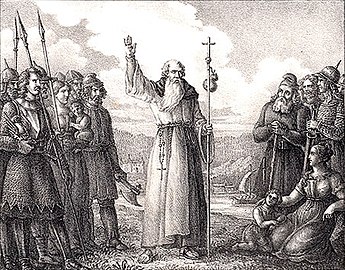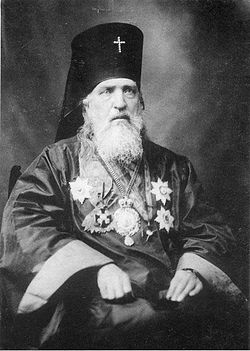Top Qs
Timeline
Chat
Perspective
February 3 (Eastern Orthodox liturgics)
Day in the Eastern Orthodox liturgical calendar From Wikipedia, the free encyclopedia
Remove ads
February 2 - Eastern Orthodox liturgical calendar - February 4

All fixed commemorations below are observed on February 16 by Eastern Orthodox Churches on the Old Calendar.[note 1]
For February 3rd, Orthodox Churches on the Old Calendar commemorate the Saints listed on January 21.
Feasts
- Afterfeast of the Meeting of Our Lord.[1][2]
Saints
- Prophet Azariah (10th century B.C.)[1][3][4][note 2]
- Holy and Righteous Symeon the God-receiver[6][7] and Anna the Prophetess[8][9] (1st century)[1][4]
- Martyrs Papias, Diodorus, and Claudianus, at Perge in Pamphylia (250)[1][10][11] (see also: October 25)
- Martyr Blaise of Caesarea in Cappadocia (3rd century)[1][4][12][13][14]
- Martyrs Paul and Simon, by the sword.[4][15]
- Martyr Paul the Syrian (284-305)[1][10]
- Martyrs Adrian[16] and Eubulus,[17] at Caesarea in Cappadocia (c. 308-309)[1][4][18]
- Venerable Claudius.[4][19]
- Saint Laurence of Canterbury, the second Archbishop of Canterbury (619)[1][10][20] (see also: February 2 - West)
Remove ads
Pre-Schism Western saints
- Saint Celerinus the Martyr (c.250)[21][22][note 3][note 4]
- Martyrs Laurentinus, Ignatius and Celerina, martyrs in North Africa (3rd century)[22][24][note 5][note 6]
- Martyrs Felix, Symphronius (Sempronius),[25] Hippolytus and Companions, a group of martyrs in North Africa.[22][23]
- Saints Tigides (4th century) and Remedius (419), two bishops who succeeded one another as Bishops of Gap in France.[22][23]
- Virgin-martyr Ia of Cornwall (Hia, Ives), a Cornish evangelist and martyr (450)[10][22][note 7]
- Saints Lupicinus and Felix, Bishops of Lyons in France (5th century)[22][23]
- Saint Laurence the Illuminator (Lawrence of Spoleto), Bishop of Spoleto, then founder of Farfa Abbey (576)[22][26][note 8]
- Saint Philip of Vienne, Bishop of Vienne in France (c. 578)[22]
- Saint Caellainn (Caoilfionn), a church in Roscommon in Ireland is dedicated to her (6th century?)[22][27]
- Saint Hadelin of Dinant, founder of the monastery of Chelles, in Belgium (690)[22][28][note 9]
- Saint Werburga of Chester, Abbess (c. 700)[1][10][22][29][30][note 10]
- Saint Berlinda of Meerbeke (Berlindis, Bellaude), a niece of St Amandus, she became a nun at Moorsel near Alost in Belgium, and later an anchoress in Meerbeke (702)[22][31]
- Saint Werburgh of Bardney, a widow who became a nun, probably at Bardney Abbey in England, where she later became Abbess (c. 785)[22][note 11]
- Saint Deodatus, a monk at Lagny Abbey in France (8th century)[22]
- Saint Ansgar of Hamburg, Bishop of Hamburg, Enlightener of Denmark and Sweden, "Apostle of the North" (865)[1][10][22][32][33][note 12][note 13]
- Saint Anatolius, a bishop in Scotland, who went to Rome on pilgrimage and settled as a hermit in Salins in the Jura in France (9th century)[22][34]
- Saint Liafdag, Bishop in Jutland in Denmark, martyred by pagans (c. 980)[22][note 14]
- Saint Oliver of Ancona (Oliverius, Liberius), a monk at Santa Maria di Portonuovo in Ancona in Italy (c. 1050)[22]
Post-Schism Orthodox saints
- Saint Sviatoslav-Gabriel and his son Saint Dimitry, of Yuriev (1253)[1][10]
- Saint Romanus of Uglich, Prince of Uglich (1285)[1][10][35][36][note 15]
- Saint Symeon of Tver, Bishop of Polotsk and Tver, first bishop there (1289)[1][10][37][38][note 16]
- Saint James (Jakov I), Archbishop of Serbia (1292)[1][10][39]
- Venerable Sabbas of Ioannina (15th century)[1][10][40][note 17]
- Saint Ignatius of Mariupol in the Crimea, Metropolitan of Gothia and Kafa (1786)[1][10][41][note 18][note 19]
- New Martyrs Stamatius and John, brothers, and their companion Nicholas, of Spetses, at Chios (1822)[1][10][4][45]
- Saint Nicholas of Japan, Equal-to-the-Apostles, Enlightener of Japan (1912)[1][10][46] [with Saint Innocent, Metropolitan of Moscow, Enlightener of Siberia and Alaska (1879)][47]
New martyrs and confessors
- New Hieromartyr Vladimir (Zagreba), Hieromonk of Borisoglebsk Monastery, Novotorzhok (1938)[1][48][49][50]
- New Hieromartyr Basil Zalessky, Archpriest, of Astrakhan (1938)[1][10][49][50]
- New Hieromartyr Adrian Troitsky, Archpriest, of Kazan (1938)[1][10][49][50]
- New Hieromartyrs John Tomilov, Timothy Izotov, Priests (1938)[10][49][50]
- Martyr Michael Agayev (1938)[10][49][50]
Remove ads
Other commemorations
- Repose of Schemamonk Paul of Simonov Monastery (1825), disciple of St. Paisius (Velichkovsky).[1][51]
- Repose of Hieromonk Isidore of Gethsemane Skete in Moscow (1908)[1]
Icon gallery
- Illustration in the Bible Historiale of King Asa of Judah destroying the idols, at Azariah's instigation.
- Righteous Symeon the God-receiver.
- Saint Werburga of Chester.
- Saints of Uglich, including St. Romanus of Uglich (second from right).
- Saint Ignatius of Mariupol in the Crimea, Metropolitan of Gothia and Kafa.
- Saint Nicholas of Japan, Equal-to-the-Apostles, Enlightener of Japan.
Remove ads
Notes
- The notation Old Style or (OS) is sometimes used to indicate a date in the Julian Calendar (which is used by churches on the "Old Calendar").
The notation New Style or (NS), indicates a date in the Revised Julian calendar (which is used by churches on the "New Calendar"). - Sts Laurentinus and Ignatius were uncles and St Celerina was an aunt of the deacon St Celerinus.
- Born in Ireland and the sister of St Ercus, she went to Cornwall with Sts Fingar, Piala and others and was martyred at the mouth of the River Hayle. The town of St Ives is called after her.
- A Syrian driven by the Monophysite persecution to Italy, there he was ordained and founded a monastery near Spoleto. He was bishop for twenty years, but then founded the monastery of Farfa in the Sabine hills near Rome. St Laurence was renowned as a peacemaker. His title derives from his gift of healing blindness, both spiritual and physical.
- Daughter of St Ermenhild and King Wulfhere of Mercia. She became a nun at Ely under St Etheldred (Audrey) and later founded three convents. She reposed at Trentham but her body was transferred to Chester, of which she is the patroness saint.
- "Werburg was the widow of Ceolred, the powerful King of Mercia, who died in the year 716. She afterwards retired to a monastery, of which she became the Abbess. Her life was prolonged many years, which she spent with such holiness, that the chronicler says it may well be believed that she went to live with Christ for ever. The day of her death is not known, but in a modern martyrology the 3rd of February is noted as her festival."[29]
- Born near Amiens in France, as a child he became a monk at Old Corbie in Picardy. He then went to New Corbie in Saxony, from where he was taken by King Harold of Denmark to enlighten the heathen Danes. He toiled there as Archbishop of Hamburg for thirteen years and his mission extended to Sweden, Norway and the north of Germany.
- He became Bishop in Jutland in Denmark and met the needs of the growing number of Orthodox there but was martyred by pagans.
- See: (in Russian) Роман Владимирович (князь углицкий). Википедии. (Russian Wikipedia).
- See: (in Russian) Симеон (епископ Тверской). Википедии. (Russian Wikipedia).
- This Greek bishop emigrated with his entire eparchy to Crimea to escape the relentless persecution of the Ottoman empire and was glorified a saint by the Ukrainian Orthodox Church (Moscow Patriarchate).[42] (In 1778, on the orders of Catherine II, 18,000 Crimean Greeks, tired of living under Ottoman rule, successfully petitioned the empress for permission to move to Russia, and were allowed to settle on the shores of the Sea of Azov, where they founded the city of Mariupol (Marianopolis).[43][44])
- See: (in Ukrainian) Ігнатій Маріупольський Готфейсько-Кафайський. Вікіпедії. (Ukrainian Wikipedia).
Remove ads
References
Sources
Wikiwand - on
Seamless Wikipedia browsing. On steroids.
Remove ads







